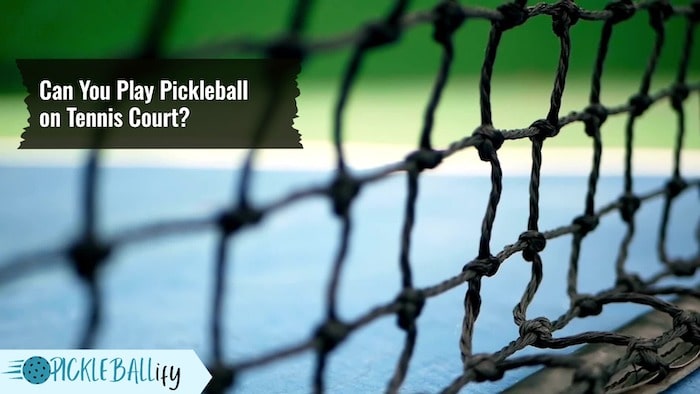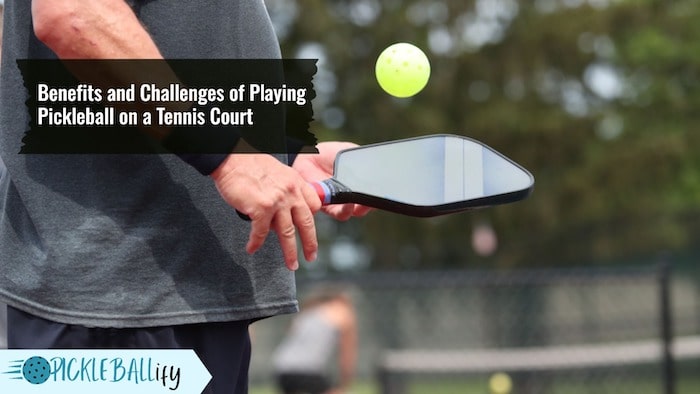Pickleball is a popular racquet sport that has gained popularity in recent years. It’s no surprise that more and more people are becoming interested in the game because it’s enjoyable and competitive. But, one frequently asked topic is whether you can play pickleball on a tennis court.

Tennis courts, after all, are frequently more easily available than dedicated pickleball courts. In this article, we will explore how to convert a tennis court into a pickleball court, the benefits and challenges of playing pickleball on the tennis court, and some tips and tricks for improving your pickleball skills on a tennis court.
Therefore, whether you enjoy pickleball or are simply interested in the sport, stay reading to learn more!
Can You Play Pickleball on Tennis Court?
Yes, you can play pickleball on a tennis court, but with some adjustments. Pickleball is a sport that combines elements of tennis, badminton, and ping pong, and can be played by people of all ages and skill levels.
It is played on a court that is similar to a doubles badminton court, with a net that is lower than a tennis net. To play pickleball on a tennis court, you will need to lower the net and mark the pickleball lines. Here are some details on how to do that:
1) Lowering the net: The standard height of a pickleball net is 34 inches at the center and 36 inches at the sidelines. The standard height of a tennis net is 36 inches at the center and 42 inches at the sidelines. To lower the net, you can use straps or weights to pull down the center of the net to 34 inches.
2) Marking the lines: The standard dimensions of a pickleball court are 20 feet by 44 feet. The standard dimensions of a tennis court are 36 feet by 78 feet. To mark the lines, you can use tape, chalk, or paint that is visible and removable. You can also use a line set like this one from Oncourt Offcourt. You will need to measure and mark the following lines:
- The baseline: This is the line at the back of the court, parallel to the net. It should be 22 feet from the center of the net on each side.
- The sideline: This is the line at the side of the court, perpendicular to the net. It should be 10 feet from the singles sideline or 15 feet from the doubles sideline of the tennis court on each side.
- The non-volley zone line: This is the line that marks the area where players cannot hit the ball before it bounces. It should be 7 feet from the net on each side.
- The centerline: This is the line that divides the court into two equal halves. It should be aligned with the center service line of the tennis court on each side.
You can fit up to four pickleball courts on one tennis court by using different configurations. You can use either temporary or permanent conversion methods, depending on your preference and permission. Here are some examples of how to do that:
- One pickleball court per tennis court: This is the easiest method, as you can use the existing net and mark only one set of lines. You can use either singles or doubles sidelines as your boundaries, depending on how much space you want.
- Two pickleball courts per tennis court: This method requires two portable nets and two sets of lines. You can place your nets parallel or perpendicular to the tennis net, depending on how much space you want behind you.
- Four pickleball courts per tennis court: This method requires four portable nets and four sets of lines. You can place your nets parallel or perpendicular to each other, depending on how much space you want between you.
How to Convert a Tennis Court into a Pickleball Court
If you want to play pickleball on a tennis court, you will need to make some adjustments to the court dimensions and markings. There are two ways to do this: temporary conversion or permanent conversion.
According to IFP “It is played both indoors and outdoors on a badminton-sized court and a slightly modified tennis net.”

Temporary conversion: Involves using tape, chalk or paint to mark the pickleball lines on top of the existing tennis lines. You will also need to lower the net to 34 inches in the center using straps or weights. You can fit up to four pickleball courts on one tennis court by using the singles sidelines as the outer boundaries.
Permanent conversion: Involves removing or covering up the existing tennis lines and painting new pickleball lines on the surface. You will also need to install new net posts or adjust the existing ones to lower the net height. You can fit up to two pickleball courts on one tennis court by using the doubles sidelines as the outer boundaries.
The Benefits and Challenges of Playing Pickleball on a Tennis Court
Playing pickleball on a tennis court has some benefits and challenges compared to playing on a dedicated pickleball court. Here are some of them:

Benefits:
- You can use an existing facility that may be more available and convenient than a pickleball court.
- You can introduce pickleball to more people who are familiar with tennis or curious about the new sport.
- You can enjoy more space and variety in your shots and strategies than on a smaller pickleball court.
- You improve your fitness level by covering more ground and hitting harder shots.
- You can practice your skills and adaptability by playing on different surfaces and net heights.
Challenges:
- You may have difficulty seeing or following the pickleball lines if they are not clearly marked or contrasted with the tennis lines.
- You may have trouble adjusting to the different net heights and bounce of the ball on different surfaces.
- You may encounter conflicts or confusion with other players who are using the same facility for different purposes.
- You may face resistance or opposition from some tennis players or authorities who are not supportive of pickleball.
- You may need to bring your own equipment and partners to play pickleball on a tennis court.
Tips and Tricks for Improving Your Pickleball Skills on Tennis Court
If you want to play better pickleball on tennis court, here are some tips and tricks that can help you:

“It is also important to note that if you are setting up an outdoor pickleball court on an existing court surface that is oriented in the normal north/south direction, do not place the pickleball courts at right angles to the court. If you do, one player will be looking directly into the sun in the early morning or late afternoon which can certainly prove to be safety hazard.” Suggested by USAPickleball.
Practice Your Serve
The serve is the most important shot in pickleball, as it sets up the rally and gives you an advantage over your opponent. On a tennis court, you have more room to place your serve and keep your opponent off balance.
Aim for the corners or the middle of the service court, and vary your speed and spin. Avoid hitting the ball too high or too long, as it will go out of bounds or give your opponent an easy return.
Master the Third Shot Drop
The third shot drop is a soft shot that lands in the non-volley zone, forcing your opponent to hit up and allowing you to move forward to the net. On a tennis court, you have more distance to cover and more time to execute this shot.
Use a continental grip and a smooth swing to hit the ball just over the net with a slight backspin. Aim for the center of the non-volley zone, and avoid hitting the ball too hard or too short.
Control the Net
The net is the most strategic position in pickleball, as it allows you to hit down and put pressure on your opponent. On a tennis court, you have more space to cover and more angles to defend at the net.
Use quick footwork and lateral movement to stay close to the net and cover the middle. Use a continental grip and a firm wrist to hit volleys and dinks with precision and control. Avoid hitting the ball too high or too wide, as it will expose you to passing shots or lobs.
Use Lobs and Overheads Wisely
Lobs and overheads are powerful shots that can change the momentum of a rally or end a point. On a tennis court, you have more opportunity and risk to use these shots. Use lobs when your opponent is at the net and you are in trouble, or when you want to create some space and time for yourself.
Aim for the baseline or the corners of the court, and use topspin or slice to make the ball bounce high or low. Avoid hitting the ball too short or too long, as it will give your opponent an easy smash or go out of bounds.
Use overheads when your opponent hits a high ball that you can reach with a full swing. Aim for the open spaces or the body of your opponent, and use topspin or flat shots to hit with power and accuracy. Avoid hitting the ball too low or too slow, as it will give your opponent a chance to recover or counter-attack.
FAQs
No, whether you play on a specialized pickleball court or a tennis court, the rules of pickleball remain the same. However, your playing technique will need to be adjusted to accommodate the greater court size and variable net height.
Yes, there are some safety concerns to consider when playing pickleball on a tennis court. The larger court size can make it more difficult to retrieve balls and may increase the risk of injury. It’s important to use caution and make sure that the court is clear before each play.
Yes, you can play pickleball indoors on a tennis court, as long as the facility allows it. Many indoor tennis facilities offer pickleball as an option, especially during the off-season.
No, playing pickleball on a tennis court has no age limits. Pickleball is a sport that individuals of all ages and ability levels may enjoy.
Conclusion
In conclusion, playing pickleball on a tennis court is a great alternative when dedicated pickleball courts are not available. While there are some differences between the two court types, the rules of the game remain the same.
With the right equipment and a few modifications, you can easily convert a tennis court into a pickleball court and enjoy the game. It’s important to use caution and make sure that the court is clear before each play to ensure safety.
Whether you’re a seasoned pickleball player or a beginner, playing on a tennis court can be a fun and rewarding experience. So grab your pickleball paddle and head to your local tennis court to give it a try!

